
 |
PRINTING |
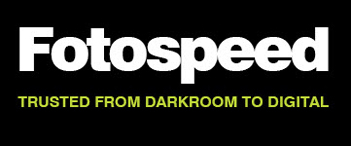 |
Click
on the Fotospeed Logo to visit the Fotospeed website For your Digital Supplies and Custom Profiling. Tel: +44 (0)1249 714555 Buy your inkjet paper from Fotospeed and get a FREE custom profile for each paper you buy. |
| Get 15% discount on Fotopeed papers by quoting the code: DD01059 | |
 |
| Click on the banner to access all of the Fotospeed YouTube Videos |
|
 Download Download |
||
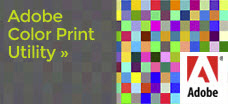 Download Download |
 |
Download as a PDF file |
PRINTING TIPS |
|
MATCHING MONITOR BRIGHTNESS, TO PRINT BRIGHTNESS |
|
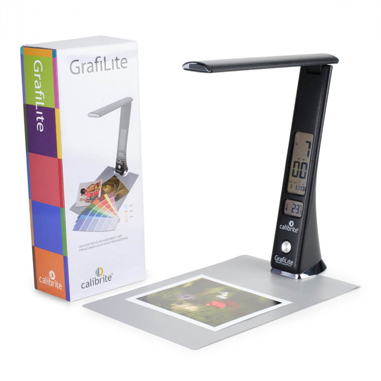 |
|
How to use a print viewing Light |
How to use a print Black & White |
CUSTOM PAPER AND INK PROFILING |
|
|
PAPER
AND INKS |
 |
A
range of papers |
|
WHAT PAPER AND
INKS SHOULD I USE ? This is a question that I get asked quite regularly and the easy answer is: the papers and inks that your printer manufacturer recommends. HOWEVER There comes a time when the inks and papers recommended by the printer manufacturer do not meet your requirements in terms of PAPER PROFILING, INK COSTS, TYPES OF INK, TYPES OF PAPER or LONGEVITY OF PRINTS. Let us look at these requirements one by one. |
INK
COSTS |
| If your printer uses color cartridges where all the colours are in one cartridge, as soon as your printer detects that ONE of these colours need replacing, it will tell you to replace the cartridge and because the usage of each colour can vary greatly, depending on the subject you print, it will be most likely that you will be throwing away the other colours of ink that haven't run out. WAYS OF REDUCING INK COSTS 1.
When
you buy a printer look for one that has an individual cartridge for each
colour of ink. 2.Buy
a printer with large capacity cartridges.
|
|
TYPES
OF INK |
1. STANDARD
DYE BASED INKS |
|
TYPES
OF PAPER |
You may want to try out different papers, so let us look at some of the different types available. 1.
MATT 2.
SATIN,PEARL or LUSTRE 3.
GLOSSY 4.
FIBRE BASED GLOSSY 5.
BARYTA PAPERS 6.
ART
|
|
CHOOSING
YOUR PAPERS |
|
| BARYTA PAPERS |
| 1. Fotospeed
Platinum Baryta 300 Signature This paper is currently my favorite for my B&W printing. Platinum Baryta 300 is a 100% acid free, Fine Art paper with a smooth unglazed gloss surface. A natural white base and state of the art micro-porous ink receiving layer delivers a high D-MAX (2.99) and wide colour gamut. Platinum Baryta 300 reveals delicate highlights and smooth transitions to shadows for both colour and B&W printing. The paper is approved by the Fine Art Trade Guild and when used in conjunction with pigment inks will ensure a print life of more than 85 years. |
 |
| SEMIGLOSS |
1. Fotospeed PLATINUM GLOSS ART FIBRE 300g Made from 100% alpha-cellulose pulp, Platinum Gloss Art Fibre 300 is a heavyweight exhibition quality paper, and is protected against environmental influence, so prints will last for decades. The paper’s archival quality makes it ideal for professional or amateur photographers who want to create long-lasting images, while its glossy finish and tonal range makes it a good choice for those who don’t want to lose detail when shooting in bright conditions. |
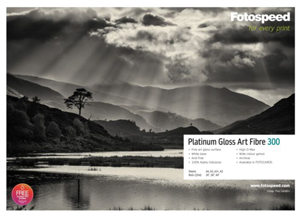 |
| MATT |
| 1.
Fotospeed Platinum Matt Fine Art Photo Paper - 280gsm Platinum Matt 280 is a 100% acid free, fine art paper. A natural white base and state of the art ink-receiving layer, delivers a high D-MAX and wide colour gamut. When used in conjunction with pigment inks, the paper will ensure a print life of more than 85 years. |
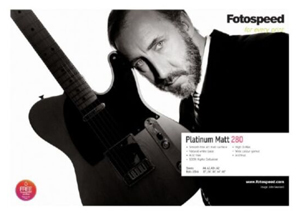 |
2.
Fotospeed Matt Ultra - 240gsm Compatible with both Dye and pigment inks Matt Ultra 240 is one of the most cost effective papers we have on the market. Originally launched in 2001, it quickly became a firm favourite. it was designed for photographers to do secondary proofing and contact sheets, but they quickly realised the quality was there to print final images. A paper well worth exploring. |
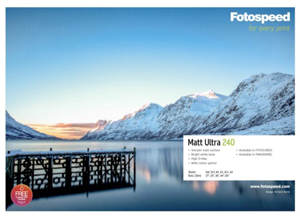 |
| ART (Smooth, slightly Textured and Textured) |
| 1.
Fotospeed Platinum Etching Cotton 310 Signature This is currently my standard slightly textured art paper. Building on the legacy of the much loved Platinum Etching 285 paper, Fotospeed proudly introduces Platinum Etching 310 - a premium upgrade designed for artists, photographers and printmakers who demand the very best in fine art printing. This next-generation paper takes everything valued in Platinum Etching 385 paper and elevates it to a 100% cotton base and an OBA-free formulation, delivering even greater archival stability and longevity. |
 |
| 2.
Fotospeed NST Bright White Signature - 315gsm This is currently my standard bright white art paper. Natural Soft Textured Bright White 315 is a 100% cotton, Fine Art paper with a very gentle texture. The paper’s bright white base and gentle texture lends itself towards landscape and portrait subjects and delivers a high D-MAX and wide colour gamut. The paper is approved by the Fine Art Trade Guild and when used in conjunction with pigment inks will ensure a print life of more than 85 years. |
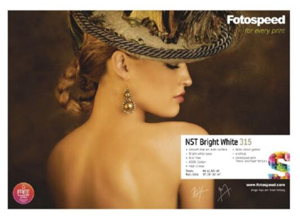 |
3.
Fotospeed High White Smooth - 315gsm High White Smooth 315 is a 100% cotton and pH neutral, Fine Art Paper with a smooth surface. A white base and a state of the art ink-receiving layer, delivers a high D-MAX and wide colour Gamut. this paper is highly recommended for Gicleé printing. The paper is approved by the Fine Art Trade Guild and when used in conjunction with pigment inks will ensure a print life of more than 85 years. High White Smooth was where it all began and has been a firm favourite of photographers and artists the world over ever since. its 100% cotton base not only gives it its archival qualities but also a sense of unrivaled quality when you hold it in your hands. |
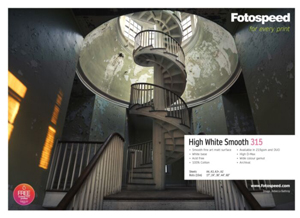 |
| 4.
Fotospeed Cotton Etching 305 This is fast becoming one of my standard natural white art papers. Cotton Etching 305 is a 100% cotton acid free Fine art paper with a white base. The surface has an etching texture which helps accentuate detail and gives a depth to your image. Cotton Etching 305 uses the latest coating technology resulting in a wide colour gamut and pin sharp detail. Cotton Etching 305 sits alongside our polular Platinum Etching 285 as a more textured alternative. The surface texture is completely different to anything we offer and helps complete the range. |
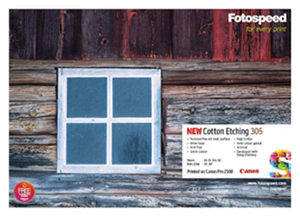 |
| 5.
Fotospeed Natural Soft Textured 315 Natural Soft Textured 315 is a 100% acid free, fine art paper with a very gentle texture. The paper’s natural white base and gentle texture lends itself towards landscape and portrait subjects and delivers a high D-MAX and wide colour gamut. The paper is approved by the Fine Art Trade Guild and when used in conjunction with pigment inks will ensure a print life of more than 85 years. |
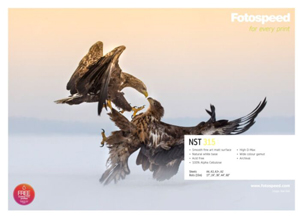 |
6.
Fotospeed Natural Textured 315g. |
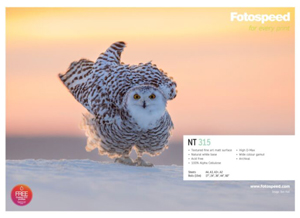 |
7.
Fotospeed Natural Textured Bright White - 315gsm |
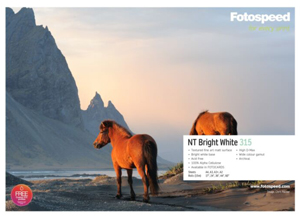 |
8.
Hahnemuhle Photo Rag Bright White 310. The lightly defined felt structure an characteristics soft Photo Rag feel gives every FineArt print an incredible depth and three-dimensional appearance. The acid- and lignin-free Photo Rag bright White meets the most exacting requirements for age resistance and is perfect for reproducing FineArt photographs and works of art. |
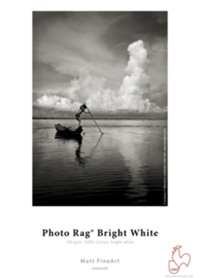 |
9. Hahnemuhle Torchon 285g. The premium matt inkjet coating produces outstanding print results, with bright colours, perfect reproduction of detail and deep black. The acid- and lignin-free Torchon paper meets the most exacting requirements for age resistance and is specially designed for FineArt use |
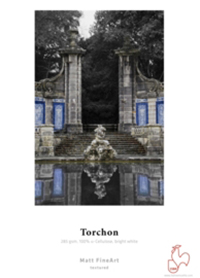 |
| GLOSSY |
1. Fotospeed PF Gloss 270g Compatible with both dye and pigment inks. |
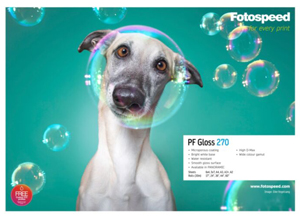 |
| LUSTRE |
1. Fotospeed PF Lustre 275 PF Lustre 275 is the corner stone of the Fotospeed Photo Quality range and should be the go to paper for any photographer. PF Lustre 275 is the perfect combination of quality and price and as a result has been recognised by photographers the world over.
|
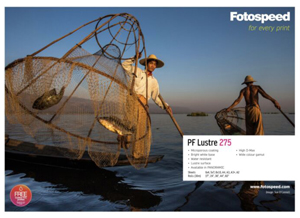 |
| PEARL |
1. Fotospeed Photo Smooth Pearl 290 |
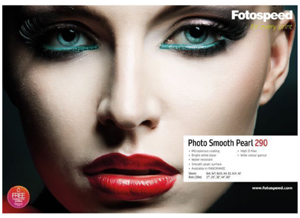 |
| SATIN |
1. Fotospeed Studio Satin 190 |
 |
| PANORAMIC PAPER |
1. Fotospeed Panoramic Paper The Test Pack contains 4 sheets of each available panoramic range papers, plus 1 sheet of each in A4 to assist with profiling. The papers include:
|
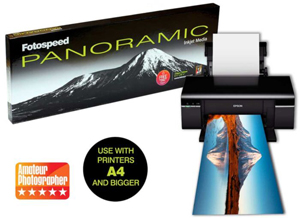 |
|
|
THE LONGEVITY OF DIGITALLY PRINTED IMAGES |
When considering the longevity of the images there are a few certainties:
|
There
are also some uncertainties:
|
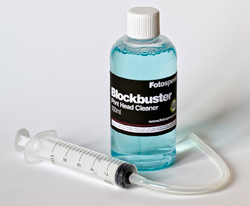 Click on image to buy Blockbuster Print Head Cleaner |
|